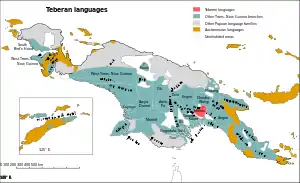Teberan languages
The Teberan languages are a well established family of Papuan languages that Stephen Wurm (1975) grouped with the Pawaia language as a branch of the Trans–New Guinea phylum.
| Teberan | |
|---|---|
| Dadibi–Folopa | |
| Geographic distribution | Papua New Guinea |
| Linguistic classification | Papuan Gulf?
|
| Subdivisions | |
| Glottolog | tebe1251 |
 Map: The Teberan languages of New Guinea
The Teberan languages
Trans–New Guinea languages
Other Papuan languages
Austronesian languages
Uninhabited | |
There are two Teberan languages, Dadibi and Folopa (Podopa). They are spoken in Southern Highlands Province and in adjoining provinces.
Classification
Malcolm Ross (2005) tentatively retains both Teberan and Pawaia within TNG, but sees no other connection between them. Noting insufficient evidence, Pawley and Hammarström (2018) tentatively leave Teberan as unclassified rather than as part of Trans-New Guinea.[2]
Pawley and Hammarström (2018) do not consider there to be sufficient evidence for Teberan to be classified as part of Trans-New Guinea, though they do note the following lexical resemblances between the Teberan languages and proto-Trans-New Guinea.[2]
- ami ‘breast’ < *amu
- kabu ‘stone’ < *ka(mb,m)u[CV]
- kolemane ‘star’ < *kala(a,i)m ‘moon’
- kile ‘eye’ < *(ŋg,k)iti
Proto-language
Some lexical reconstructions by Usher (2020) are:[3]
gloss Proto-Dadibi-Folopa Dadibi Folopa head *tobo tobo-lu tobo hair/feather *ni[g]i nisi niki ear/hear *[w]odzo olo ~ odo- woso 'hear'; woseni 'ear' eye *ge[…] ge-du kele nose *gun… guni gunumu; kurumu tongue *kamina hamina bone *di[l/r]i dili diri skin/bark *wadz[i/e] wali wase breast *ame ame ame dog *j[o]wi jowi ~ juwi juwi pig *kibu kibu hupu bird *ba ba ba egg/seed *ge ge ke tree/wood *ni ni ni woman/female *so so so sun/day *s[u]g[a] sogo suka water *wẽi wẽ wẽi fire/sun *si[a] sia si path/door *tũ tũ tũ ~ tu eat/drink *nV- n-/nuku- (present) one/another *me me me
Vocabulary comparison
The following basic vocabulary words are from Macdonald (1973),[4] as cited in the Trans-New Guinea database:[5]
gloss Dadibi Folopa (Sopese dialect) Folopa (Bɔro dialect) Folopa (Suri dialect) Tebera head tobudu topo tobo dobo tobuřo hair tobudu nizi topo neki tobu nigi dobu nigi tobu nigi ear ořo woleke usani ořoge ozini eye gedu kele kɩle geře kʌle nose guni fopa ai fobaʔai fobai gunumu tooth kɛli seřeke sɛřɛge sɛřɛge sega̧ tongue hamiya hape habe gonoma habi leg sa̧ga̧ holȩke ho̧ hořoge hɔ louse no̧u̧ doi dui dui dui dog yowi ha̧u̧ ha̧o̧ ha̧o̧ ha̧o̧ bird ba ba ba ba ba egg ba ge ba ke ba ge ba age ba ge blood kanimi wi fage fage fɛ̧ bone dili təři dʌři dʌři dɩli skin tigiwali tiki sɛ̧ga̧i̧ sɛ̧ga̧i̧ sɛ̧ga̧i̧ breast ami awa̧ a̧u̧wa tigi a̧i̧ ami tree ni ni ni ni ni man bidi hwȩ hwi̧ hwi̧ hwi̧ woman we šo sou sou sou sun giliga suḳʷa sugua teřeuna yȩ moon podua kasiapu ha̧di haři koi water a̧i̧; wȩ ipi wȩi̧ wi̧ wȩi̧ fire sia si si si si stone mazigi kapo kʰani gabo kabo name nogi doi doi nimi diai eat tubo nae nai nae nugidabo one dɛlɛli peta̧ti mɛ̧ koři sali demo mɛzazibo two si tapala tamo tamu damo dabada damubo
References
- New Guinea World, Tua River
- Pawley, Andrew; Hammarström, Harald (2018). "The Trans New Guinea family". In Palmer, Bill (ed.). The Languages and Linguistics of the New Guinea Area: A Comprehensive Guide. The World of Linguistics. 4. Berlin: De Gruyter Mouton. pp. 21–196. ISBN 978-3-11-028642-7.
- Timothy Usher, New Guinea World, Proto–Dadibi–Folopa
- Macdonald, G.E. "The Teberan Language Family". In Franklin, K. editor, The linguistic situation in the Gulf District and adjacent areas, Papua New Guinea. C-26:111-148. Pacific Linguistics, The Australian National University, 1973. doi:10.15144/PL-C26.111
- Greenhill, Simon (2016). "TransNewGuinea.org - database of the languages of New Guinea". Retrieved 2020-11-05.
- Ross, Malcolm (2005). "Pronouns as a preliminary diagnostic for grouping Papuan languages". In Andrew Pawley; Robert Attenborough; Robin Hide; Jack Golson (eds.). Papuan pasts: cultural, linguistic and biological histories of Papuan-speaking peoples. Canberra: Pacific Linguistics. pp. 15–66. ISBN 0858835622. OCLC 67292782.
External links
- Timothy Usher, New Guinea World, Proto–Dadibi–Folopa